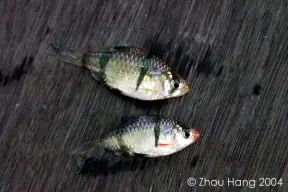Puntigrus pulcher
SynonymsTop ↑
Puntius pulcher Rendahl 1922; Systomus pulcher (Rendahl 1922)
Etymology
Puntigrus: formed from part of the generic name Puntius and tigrus, a word created to sound like the Latin word tigris, meaning ‘tiger’, in allusion to the barred colour pattern and the common name ‘tiger barb’ used for some members.
pulcher: from the Latin pulcher, meaning ‘beautiful’, presumably in reference to the species’ attractive colour pattern.
Classification
Order: Cypriniformes Family: Cyprinidae
Distribution
Endemic to the Indonesian portion of eastern Borneo. The precise extent of its range is unclear, but official records exist from the Kayan River in Kalimantan Utara (North Kalimantan) province and the Mahakam River in Kalimantan Timur (East Kalimantan).
Type locality is ‘Kayan River, near Bulungan, northeastern Borneo, Indonesia’.
Habitat
Unconfirmed, but congeners tend to inhabit forest streams and tributaries containing relatively clear water and sandy to rocky substrates.
Maximum Standard Length
At least 27.4 mm, probably 50-60 mm.
Aquarium SizeTop ↑
An aquarium measuring at least 80 ∗ 30 cm is required.
Maintenance
Choice of décor is not especially critical though it should display better colouration in a well-decorated set-up. The addition of floating or overhanging vegetation and driftwood roots or branches also seems to be appreciated by members of this genus.
Water Conditions
Temperature: 20 – 26 °C
pH: 5.0 – 7.5
Hardness: 18 – 179 ppm
Diet
Probably an omnivore feeding on insect larvae, zooplankton, plant material and organic detritus.
In the aquarium offer regular meals of small live and frozen foods such as chironomid larvae (bloodworm), Daphnia, and Artemia alongside good quality dried products.
Behaviour and CompatibilityTop ↑
Limited aquarium observations suggest this species to be peaceful when provided with a sufficiently large aquarium and well-chosen tankmates.
It is a gregarious species forming loose hierarchies, with rival males continually battling with each other for female attention and hierarchical position within the group. A group of at least 8-10 specimens should therefore be considered the minimum purchase.
Sexual Dimorphism
Adult males tend to be slightly smaller, slimmer, and possess a more intense colour pattern than females.
Reproduction
Has been achieved in aquaria on at least one occasion.
NotesTop ↑
This species occasionally appears in the aquarium hobby, but the trade is largely reliant on commercially-produced ‘tiger barbs’ of questionable origin.
It was considered a synonym of P. anchisporus for a number of decades following Alfred (1963), but revalidated by Kottelat and Tan (2011).
P. pulcher is distinguished from congeners by the following combination of characters: lateral line incomplete with 10-11 pored scales; 12 circumpeduncular scale rows; 19-21+2 scales in the lateral row; dorsal-fin entirely black, lower anterior portion grey; pelvic fins black; black body bars 1.5 scales wide.
The genus Puntigrus was raised by Kottelat (2013) in order to accommodate a group of species formerly referred to as the ‘Puntius tetrazona group’. Other members are P. tetrazona, P. navjotsodhii, P. pulcher, and P. partipentazona, of which the first three are native to western, central, and eastern Borneo, respectively, and the latter to Indochina.
This assemblage is diagnosed by possession of a unique colour pattern comprising 4 black bars on a pale body, and black pigmentation on at least the basal half of the dorsal-fin. The anteriormost body bar passes through the eye, the second is anterior to the pelvic-fin base, the third is above the anal-fin and continues onto it, and the posteriormost is at the caudal-fin base.
The following combination of characters also aid in identification, although individually they are not unique to the genus: body rhomboid, deep; last simple dorsal-fin ray serrated posteriorly; rostral barbels absent; maxillary barbels present; lips smooth and thin, postlabial groove interrupted medially; lateral line complete or incomplete; 18–23 lateral line scales; 9½–10½ [5½/1/3–4½] scale rows between dorsal-fin origin and ventral midline anterior to pelvic-fin base; 12–14 circumpeduncular scale rows; 8–9 rakers on first gill arch.
The genus Puntius was previously viewed as a polyphyletic catch-all containing over 100 species, but this situation has been largely resolved since the turn of the century.
References
- Rendahl, H., 1922 - Nytt Magazin for Naturvideenskapen 5(60): 199-204
Fische, gesammelt von Herrn Carl Lumholtz in Bulugan, Northost-Borneo, 1914. - Alfred, E. R., 1963 - Bulletin of the Singapore National Museum 32: 135-142
Some colourful fishes of the genus Puntius Hamilton. - Kottelat, M., 2013 - Raffles Bulletin of Zoology Supplement 27: 1-663
The fishes of the inland waters of southeast Asia: a catalogue and core bibiography of the fishes known to occur in freshwaters, mangroves and estuaries. - Kottelat, M. and H. H. Tan, 2011 - Ichthyological Exploration of Freshwaters 22(3): 209-214
Systomus xouthos, a new cyprinid fish from Borneo, and revalidation of Puntius pulcher (Teleostei: Cyprinidae). - Roberts, T. R., 1989 - Memoirs of the California Academy of Sciences No. 14: i-xii + 1-210
The freshwater fishes of western Borneo (Kalimantan Barat, Indonesia).


